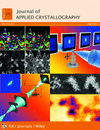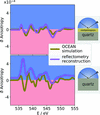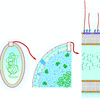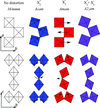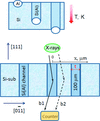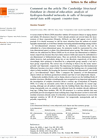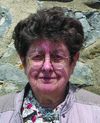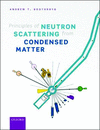issue contents
April 2021 issue

Cover illustration: Schematic of Escherichia coli structure and composition. Semeraro et al. [J. Appl. Cryst. (2021), 54, 473–485] have revised a previously reported multi-scale model for (ultra-)small-angle X-ray and (very) small-angle neutron scattering of live E. coli on the basis of compositional/metabolomic and ultrastructural constraints.
editorial
Free 

A virtual special issue of Journal of Applied Crystallography brings together 14 articles from developers and practitioners in the field of ptychography, highlighting some developments in software and algorithms, instrumentation, technical requirements, and applications.
lead articles
Open  access
access
 access
accessIn the era of diffraction-limited storage rings, can X-ray nanoimaging be extended to millimetre- or even centimetre-sized specimens such as whole mouse brains? The authors believe so and provide size-dependent imaging time and resource estimates based on calculated flux requirements and recent method developments in related disciplines.
research papers
Open  access
access
 access
accessThe refractive index of a y-cut SiO2 crystal surface is reconstructed from polarization-dependent soft X-ray reflectometry measurements in the energy range from 45 to 620 eV. The reconstructed anisotropy in the optical constants is also confirmed by ab initio Bethe–Salpeter equation calculations of the O K edge.
A new theoretical approach has been developed to provide an intuitive view of the focusing and energy-dispersion properties of bent Laue crystals.
The linear background function to be used in whole-powder-pattern fitting is derived by applying least absolute shrinkage and selection operator (LASSO) and tree search. It gives excellent fits with a smaller number of adjustable parameters than the currently used polynomials, without introducing undulation into the calculated background curve. Basic algorithms used in statistics and machine learning are demonstrated to be useful in developing an analytical model in X-ray crystallography.
Surface relaxation contributes to the formation of residual contrast of threading edge dislocations in X-ray back-reflection topographs under g · b = 0 and g · b × l = 0 conditions.
A method for generating the atomic pair distribution function from powder diffraction data that removes instrument and emission profile aberrations has been developed. The method uses a nonlinear least-squares deconvolution technique incorporating penalty functions as implemented in the computer program TOPAS.
A spin-contrast-variation neutron powder diffractometry technique is developed, where the coherent scattering length of hydrogen is controlled by proton polarization. This technique extracts the hydrogen structure factor, i.e. the contribution of hydrogen atoms to a crystal's structure factor.
Open  access
access
 access
accessMeasurements and methods of mitigation for small-angle neutron scattering instrument background caused by extraneous scattering from surfaces are presented.
Open  access
access
 access
accessStructural and compositional information about Escherichia coli cells is summarized and translated into an analytical multi-length-scale scattering form factor model of live bacterial suspensions.
Open  access
access
 access
accessA new tomographic approach using X-ray scattering is presented, allowing the characterization of the 3D nanostructure of hybrid materials.
Synchrotron X-ray diffraction data of Fe powder have a super-Lorentzian peak shape with anisotropic peak broadening. Detailed microstructural (unimodal and bimodal) analyses were carried out using the Rietveld method, modified Williamson–Hall plots and whole powder pattern modelling to investigate these features of the diffraction pattern. The bimodal analysis approach gives improved profile fitting, with the two components of the microstructure having different dislocation densities and a broad lognormal crystalline domain size distribution.
The effects of crystal orientation and detector distance on the ability to resolve pseudosymmetry using new intensity-based indexing methods of electron backscatter diffraction are studied. These results quantitatively demonstrate that certain orientations are significantly easier to correctly index and illustrate the clear benefit of shorter detector distances.
An algorithm for automated identification and removal of spurious data from Bragg coherent diffraction imaging data is presented. This algorithm provides a drastic improvement in the efficiency of data processing by replacing the slow process of manually identifying and deleting spurious data.
Open  access
access
 access
accessThis article reports the first in situ diffraction result collected under applied electric field on a hybrid improper ferroelectric which shows a subtle yet robust preference for a switching mechanism that proceeds via an unwinding of the octahedral rotation mode.
Small-angle neutron scattering measurements of mixtures of hydrogenous and deuterated n-tetradecane
Small-angle neutron scattering of mixtures of hydrogenous and deuterated n-tetradecane, a typical linear n-alkane, can be used to determine the distribution of the molecules, in the same way as for mixtures of isotopically labeled polymers.
Neutron polarization analysis using a 3He spin filter for mainly soft matter systems is demonstrated for small-angle neutron scattering with a pulsed neutron source; successful separation of the coherent scattering component from the incoherent scattering component due to hydrogen atoms was achieved.
Open  access
access
 access
accessIt is a challenge to distinguish the effect of shape fluctuations and size polydispersity on experimental small-angle X-ray scattering curves of small unilamellar vesicles. Here it is shown that both effects have distinguishable spectral patterns, and an efficient simulation tool is presented for simulating and analysing experimental data. The importance of curvature-induced electron-density profile asymmetry for estimating the vesicle size from SAXS scattering curves is also demonstrated.
This work introduces a new approach to improve the current state of the art in prior austenite phase reconstruction in steels.
Open  access
access
 access
accessCoordinate-free expressions for the form factors of arbitrary polygons and polyhedra are derived using the divergence theorem and Stokes's theorem. Series expansions are used to ensure numeric precision close to apparent singularities.
High-resolution X-ray Laue diffraction in an Si wafer patterned with vertically aligned Al-doped 100 µm-wide channels extending through the whole wafer was studied experimentally and simulated using the Takagi–Toupin dynamical diffraction theory. The calculated angular dependences of the intensities of both the diffracted and the transmitted X-ray beams corroborate the experimentally measured rocking curves and demonstrate their high sensitivity to the structural distortions in the channel.
A new imaging method to visualize differences of d values in the same sample has been applied to bulk steel materials. Some crystal grains are visible, and the strains caused by the Vickers mark are also quantitatively visualized.
Download citation


Download citation


The room-temperature crystal structure of the elpasolite scintillator Tl2LiYCl6 was determined for the first time to be in the space group P42, and the evolution of the crystal structure up to 725 K was studied in detail, revealing a structural transition from P42 tetragonal to Fm3m cubic at 464 K.
CCDC reference: 2064359
Open  access
access
 access
accessA novel approach to the quantification of the agreement between pair distribution functions by a similarity measure based on cross-correlation functions is introduced and evaluated.
A new method for electron backscatter diffraction ab initio indexing is reported. As a new sorting criterion for the solutions of Kikuchi-pattern indexing, generalized de Wolff figures of merit are also introduced.
A new sample stage dedicated to X-ray powder diffraction of actinide materials, and adaptable on a conventional Bragg–Brentano goniometer, is presented. This new experimental setup may also be used for the encapsulation of atmosphere-sensitive materials (not only radiotoxic samples).
teaching and education
Free 

This article reviews the core concepts of scattering and structure factor that are used to analyze structures of ordered and disordered samples. Simulations of scattering photography and intensity scanning of typical examples are provided, along with CPU and GPU source codes.
CIF applications
Open  access
access
 access
accessData curation practices of the Crystallography Open Database are described with greater focus being placed on the cif_validate program, capable of validating crystallographic information files against both DDL1 and DDLm dictionaries.
computer programs
Open  access
access
 access
accessA multi-platform open-source Python-based graphical user interface has been developed to provide access to automated classification and data management tools for biomolecular crystallization screening.
This work presents an open-source Python-based module for calculating the chord distribution function from the small-angle X-ray scattering pattern of polymer materials with fiber symmetry.
DATAD, a Python-based X-ray diffraction simulation code, has been developed for simulating one- and two-dimensional diffraction patterns of a polycrystalline specimen with an arbitrary texture under an arbitrary deformation state and an arbitrary detection geometry
Open  access
access
 access
accessMATSAS analyses X-ray and neutron small-angle scattering data obtained from porous systems. MATSAS delivers a full suite of pore characterizations, including specific surface area, porosity, pore size distribution and fractal dimensions.
letters to the editor
A comment is made on the use of terms such as `low-dimensional structure'.
crystallographers
Free 

book reviews
Free 

Free 

Free 



 journal menu
journal menu








